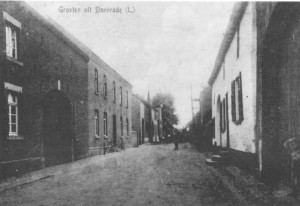Aunt Sophie
Sophia Lichtenstein (Dutch link) was born on 10 May 1904 in Jülich. She married her first husband Max Baum there on 1 Feb 1935. For a while they lived in Linnich (Kirchstr. 12), but in 1938 they moved to Doenrade in the Netherlands. There they lived at Kerkstraat 74. The house had a cafe at the first floor and two apartments on the second floor. Max and Sophie lived on the right hand side (in the photo bikes are parked in front of the house). According to Red Cross data, Max worked as a  mechanic and chauffeur to make a living, but according to Rosemary Smeets (pers. correspondence) Max owned a furniture store. He employed a young secretary, with whom they seemed to have had a good relationship. For a while life went on with all the restrictions that living in occupied territory brings with it.
mechanic and chauffeur to make a living, but according to Rosemary Smeets (pers. correspondence) Max owned a furniture store. He employed a young secretary, with whom they seemed to have had a good relationship. For a while life went on with all the restrictions that living in occupied territory brings with it.
But on 25 Aug 1942 the Germans burst into the store, and arrested Sophie and Max. Who betrayed them is not known.
They had to go by tram to the Sittard train station, and from there were sent to Westerbork in Drenthe, a transit camp. From there they were sent to Camp Vught, where Max was forced to work for the Germans. In the summer of 1943 they were sent back to Westerbork, to be transported to Auschwitz two months later. Max died in teh hospital in Auschwitz III (Monowitz-Buna). Sophie was the subject of medical experiments, which were led by SS-Brigadeführer Prof. Clauberg. She was sent to various camps, but eventually did survive the war.
Many books are written about the experiences in the camps. Helga Herzberg, a survivor, wrote “Through the Eye of the Needle” in 2006. She meets Sophie in Birkenau, Block 19 in April of 1944. She writes (pg.43-44, loosely translated):
From the group I slept with, I got along best with Sophie, a Jewsih woman from Geleen. She was twice as old as I was, but escaped the selection, prrobably because she looked very young for her age.
We slept with six people on one bunk. Everyone was cold, because there was no heat, no mattresses, you had to share one blanket with six people. We alternated who slept in the middle, which was the warmest place.
One of the worst things was standing at roll call. We had to stand for hours without moving, if you moved you got beaten. The supposed purpose was to see if everyone was present, but the numbers were never right. After roll call we got thin soup in a large container without spoons. This was for everyone, and frequently fights broke out because someone was perceived as taking more than their share.
And that is only the beginning. Eventually Sophie and Helga are liberated by the Allies.
In 2009 I was contacted by Drs. Rosemarie M. C. Smeets. She is writing a book about the history of the village of Doenrade. She wanted to know what I knew about Sophie, and gave us some more information, and the picture of the house. The book has not appeared yet, however.
Recently we were notified that the town of Geleen (the village of Doenrade is part of Geleen) want to name a street after Sophie and Max. We are a bit ambivalent about all this sudden interest. Yes we want people to remember Sophie and Max, and especially we want people to remember the atrocities that happened in the war, but why now, after more than 50 years? Is it still guilt, or a real desire to try to make something right? Or what?
I’m puzzled.

Leave a Reply